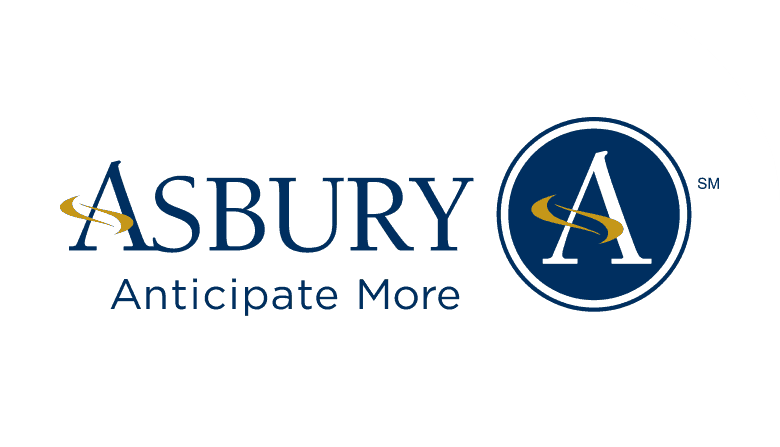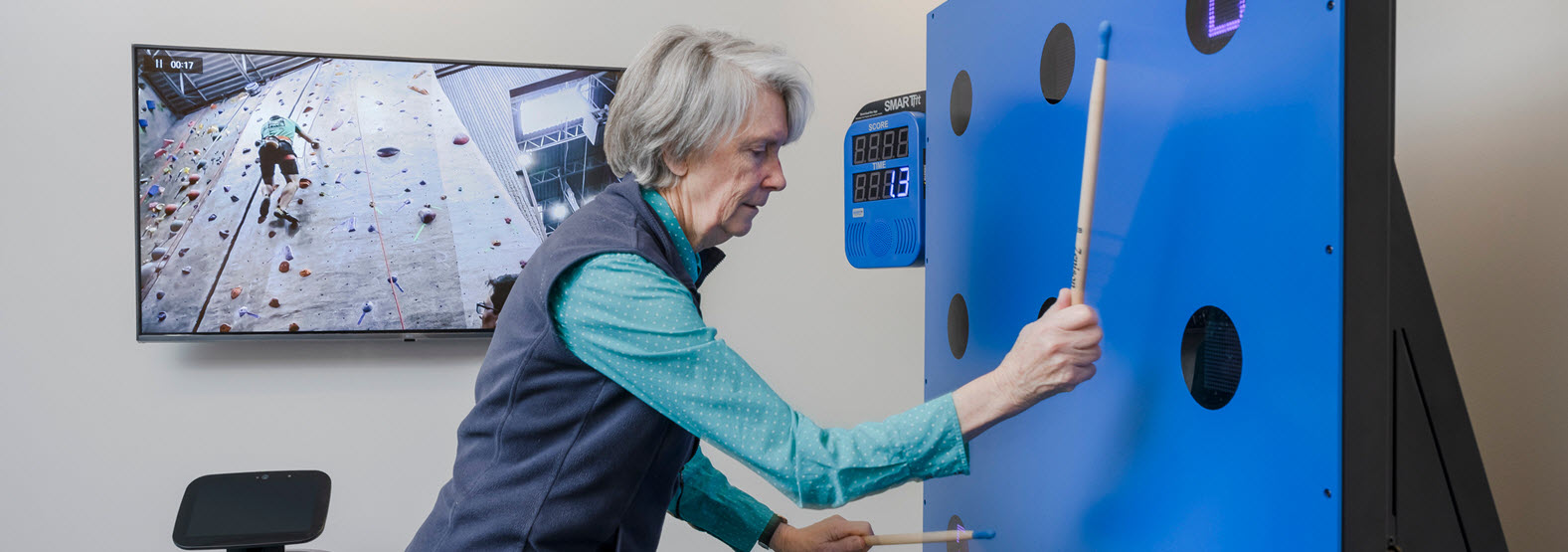Optimizing Cognitive Wellness with Dual Task Training
By Sue Paul, Senior Director of Well-Being and Brain Health
As we age, maintaining cognitive function and preventing falls becomes increasingly crucial. Recent research sheds light on the potential of dual task training in addressing both concerns effectively. By engaging in activities that challenge the brain and body simultaneously, older individuals can not only enhance cognitive abilities but also fortify balance and coordination, ultimately fostering independence and an improved quality of life.
See below for dual task training exercises you can do at home!
What is dual task training?
Dual task training involves simultaneously performing cognitive and motor tasks, mirroring everyday multitasking demands. Aging adults may notice a subtle decline in walking and talking simultaneously, indicating the need for training. Engaging in dual tasks enhances attention, task-switching, and cognitive resilience.
How does dual task training help cognition?
Numerous studies emphasize the cognitive benefits of dual task training, especially among older adults. These activities stimulate neuroplasticity, the brain’s ability to reorganize and form new neural connections, leading to improvements in memory, attention, and executive function. Dual task training has also shown promise in reducing the risk of cognitive decline and offering protective effects against neurodegenerative diseases such as Alzheimer’s.
How does dual task training help fall prevention in seniors?
Beyond cognitive advantages, dual task training plays a pivotal role in fall prevention among seniors. Falls pose a significant health risk, resulting in severe injuries and diminished mobility. Dual task activities challenge individuals to maintain balance and coordination while performing cognitive tasks, mimicking real-world scenarios that require divided attention. By honing these skills, older adults can navigate hazards safely, reducing the risk of falls and enhancing overall mobility.
Dual task training and exergaming at Asbury senior living
As Asbury Communities shapes our Kinnections brain health programs, we are integrating dual task training and exergaming for a comprehensive solution. Notably, SMARTFit and Senso, among the utilized technological tools, shine as exergaming devices, making dual task training both measurable and enjoyable.
Exergaming, which integrates physical activity in video games, provides a captivating platform for merging cognitive and motor tasks. This fusion, known as cognitive-motor integration, positions exergaming as a promising strategy for enhancing both cognitive health and physical fitness in older adults. The partially immersive and stimulating nature of exergames promotes neuroplasticity, fostering the creation of new neural connections and amplifying cognitive resilience. Additionally, the dynamic and adaptive features of exergames ensure continual challenges, enabling skill refinement and offering a sustainable approach to cognitive enrichment.
How does exergaming help fall prevention?
Beyond cognitive benefits, exergaming addresses the significant health risk of falls, minimizing injuries and enhancing mobility. These activities mirror real-world scenarios, demanding individuals to balance and coordinate while engaging in cognitive tasks. By refining these skills, older adults navigate hazards more safely, reducing fall risks and improving overall mobility.
Exergaming offers a secure environment for practicing balance, coordination, and mobility. Within virtual scenarios, users navigate challenges, performing motor tasks while engaging in cognitive activities. This dual task training cultivates adaptive strategies, promoting stability and reducing fall risks, adding confidence and independence in daily activities.
Three Dual Task Training Activities You Can Do at Home
- Walking and Counting Aloud: While taking a brisk walk, count backward from 100 by threes or recite a favorite poem aloud. This activity requires coordination between walking and cognitive processing, enhancing attentional control and gait stability.
- Balancing and Alphabet Recitation: Stand on one leg while reciting the alphabet backward or spelling words aloud. This exercise challenges balance and proprioception while engaging cognitive functions such as working memory and mental flexibility.
- Ball Toss and Word Association: Stand facing a partner and toss a soft ball back and forth while verbally associating words with a given category (e.g., animals, fruits). This activity demands coordination, visual tracking, and cognitive flexibility as participants switch between motor and cognitive tasks rapidly. You can also do this by yourself while tossing a ball up and down- just try to maintain an even cadence!
By integrating dual task activities into their daily routines, older adults can harness the synergistic benefits of cognitive-motor integration, enhancing both mental acuity and physical resilience. As research in this field continues to evolve, embracing dual task training holds immense potential in optimizing well-being and fostering independence among seniors.
About the Author
Sue Paul is the Senior Director of Wellness and Brain Health for Asbury Communities. She is a licensed occupational therapist with more than 30 years of experience working with older adults with orthopedic and neurological conditions, specializing in neurodegenerative diseases including Alzheimer’s and Parkinson’s disease. Sue is a Certified Health Coach and Functional Aging Specialist, as well as a Brain Trainer, Certified through the American Council on Exercise. She was appointed to the Virginia I. Jones Alzheimer’s and Related Disorders Council by Governor Hogan in 2020 and was a long-time ambassador for the Alzheimer’s Association to Maryland’s Congressional 6th District. Sue is the founder and executive director of SeniorScapes, Inc., a non-profit whose mission is to create safe, accessible, dementia-friendly public parks for older adults.
Article References
- Versi N, Murphy K, Robinson C, Franklin M. Simultaneous Dual-Task Interventions That Improve Cognition in Older Adults: A Scoping Review of Implementation-Relevant Details. J Aging Res. 2022 Mar 29;2022:6686910. doi: 10.1155/2022/6686910. PMID: 35392021; PMCID: PMC8983262.
- Ali, N., Tian, H., Thabane, L. et al. The Effects of Dual-Task Training on Cognitive and Physical Functions in Older Adults with Cognitive Impairment; A Systematic Review and Meta-Analysis. J Prev Alzheimers Dis 9, 359–370 (2022). https://doi.org/10.14283/jpad.2022.16
- Silsupadol P, Shumway-Cook A, Lugade V, van Donkelaar P, Chou LS, Mayr U, Woollacott MH. Effects of single-task versus dual-task training on balance performance in older adults: a double-blind, randomized controlled trial. Arch Phys Med Rehabil. 2009 Mar;90(3):381-7. doi: 10.1016/j.apmr.2008.09.559. PMID: 19254600; PMCID: PMC2768031.
- AJPM. (2012, February). Cay Anderson-Hanley. American Journal of Preventative Medicine. https://scholar.google.com/citations?user=Lw3kTjwAAAAJ&hl=en
- Cybercycling AJPM. (2012, February). Cay Anderson-Hanley. American Journal of Preventive Medicine.
- Basak, C., & Abstract Behavioral interventions that can slow the progress of age-related cognitive declines have attracted much attention in recent decades. With the advancement of technology. (2018, March 23). Virtual cognitive training in healthy aging and mild cognitive impairment. Aging, Technology and Health. https://www.sciencedirect.com/science/article/abs/pii/B9780128112724000099?via%3Dihub
- Gheysen, F., Poppe, L., DeSmet, A. et al. Physical activity to improve cognition in older adults: can physical activity programs enriched with cognitive challenges enhance the effects? A systematic review and meta-analysis. Int J Behav Nutr Phys Act 15, 63 (2018). https://doi.org/10.1186/s12966-018-0697-x
- Effects of Exergame-Based Dual-Task Training on Executive Function and Dual-Task Performance in Community-Dwelling Older People: A Randomized-Controlled Trial Ray-Yau Wang, Yuan-Chen Huang, Jun-Hong Zhou, Shih-Jung Cheng, and Yea-Ru Yang Games for Health Journal 2021 10:5, 347-354




